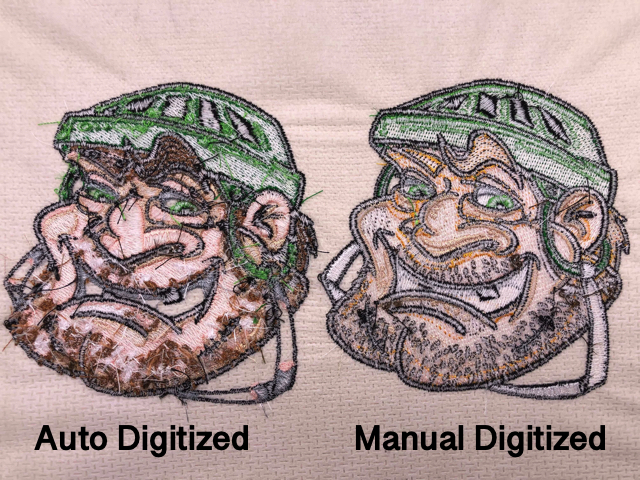Economical Digitizing for Embroidery: Accuracy and Detail
Economical Digitizing for Embroidery: Accuracy and Detail
Blog Article
Grasping the Embroidery Digitizing Process: Your Ultimate Overview
Embroidery digitizing is a precise craft that needs precision and proficiency to equate detailed designs into electronic formats for equipment needlework. As craftsmens begin on this journey to master the needlework digitizing process, a comprehensive understanding of the basics establishes the foundation for quality.

Recognizing Needlework Digitizing Fundamentals
Needlework digitizing basics form the foundation whereupon intricate layouts are converted into machine-readable layouts for precise sewing. This first action in the embroidery digitizing procedure is crucial for guaranteeing that the last embroidered item is a faithful representation of the initial style. Comprehending needlework digitizing essentials includes understanding key concepts such as stitch kinds, sew direction, density, padding, and pull settlement.
Stitch kinds play a vital duty in determining the visual and textural result of the embroidered layout. By choosing the proper stitch kind, whether it be satin, fill, or running stitch, digitizers can achieve the wanted effect and enhance the general high quality of the needlework. Additionally, sew instructions affects the circulation and measurement of the style, while thickness figures out the spacing and coverage of the stitches.
Moreover, underlay sewing offers security to the design by safeguarding the material and protecting against distortion throughout the needlework procedure. Draw settlement is another important factor to consider to neutralize the natural tendency of material to agreement when stitched. Grasping these embroidery digitizing essentials is fundamental for producing professional-quality stitched items.
Selecting the Right Digitizing Software Application
Picking the suitable digitizing software application is an essential decision that considerably affects the performance and top quality of the embroidery digitizing process. Digitizing for Embroidery. When selecting the ideal digitizing software, it is vital to think about elements such as the intricacy of layouts you plan to produce, the user-friendliness of the software program, the level of consumer support used, and the compatibility with your embroidery maker
There are different digitizing software options available on the market, ranging from fundamental programs for beginners to sophisticated software application for professional digitizers. Some prominent options consist of Wilcom EmbroideryStudio, Hatch Needlework Software, and PulseID. These software bundles offer a variety of devices and functions to aid you produce elaborate styles effortlessly.
Before deciding, it is suggested to check out the different software program choices via totally free tests or trials to establish Source which one best matches your requirements. In addition, reviewing testimonials and looking for suggestions from skilled digitizers can give valuable insights into the strengths and weaknesses of each software (Digitizing for Embroidery). By carefully assessing your demands and comparing the functions of various digitizing software program, you can make an educated option that enhances your embroidery digitizing process
Digitizing Tools and Methods

Optimizing Style Setup for Needlework
Grasping the intricacies of style settings is basic in attaining ideal outcomes in the needlework digitizing process, structure upon the structure laid by comprehending digitizing devices and techniques. When maximizing style setups for needlework, it is More Info necessary to think about elements such as stitch kind, thickness, padding, pull payment, and registration. Stitch type choice affects the total appearance and feeling of the style, with options like satin, fill, and running stitches providing find out this here various structures and results. Thickness refers to the spacing and density of stitches, impacting the layout's coverage and longevity. Correct rug stitching offers security and avoids fabric distortion, especially for complicated designs or on elastic products. Pull compensation adjusts for textile stretch throughout stitching, ensuring exact design replication. Enrollment settings straighten different elements of the style precisely, keeping overall layout integrity. By fine-tuning these layout setups, embroiderers can boost the high quality and precision of their embroidered productions.

Troubleshooting Common Digitizing Issues
When running into common digitizing problems during the embroidery procedure, it is vital to comprehend the root triggers and apply effective options promptly. One usual trouble is stitch density issues, where stitches might be also thick, triggering the textile to tighten, or too sporadic, bring about gaps in the style. Adjusting the stitch density settings in the digitizing software program can assist settle this problem.
An additional regular difficulty is thread breaks during the needlework procedure. This can take place as a result of various reasons such as inaccurate stress settings, plain needles, or using low-quality string. Ensuring correct maintenance of the needlework machine, including normal needle modifications and stress adjustments, can minimize the incident of string breaks.
Furthermore, layout registration errors can lead to misaligned elements within the needlework style. Examining the design alignment in the digitizing software and making essential modifications prior to sewing can aid in preventing this problem. By dealing with these common digitizing concerns promptly and efficiently, you can make sure a smoother embroidery process and high-grade finished products.
Verdict
To conclude, grasping the embroidery digitizing procedure calls for a solid understanding of the fundamentals, the best selection of software, and knowledge of tools and methods. Maximizing design settings and fixing common digitizing issues are critical action in guaranteeing top notch embroidery outcomes. By adhering to these actions faithfully, one can attain precision and performance in the digitizing procedure.
Report this page